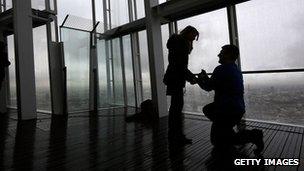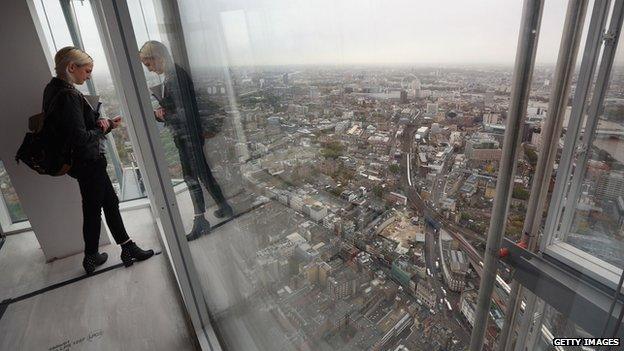Does Shard point to design's future?
- Published
Spencer Kelly looks at some of the technology in the Shard
Western Europe's tallest building, the Shard, opened in London with a fanfare earlier this year. But does it represent the latest in building design and technology, or is it already being outpaced?
The opening of the Shard's public viewing platform, some 243m (800ft) up the tower, was marked with a ribbon-cutting ceremony by the London Mayor and a wedding proposal.

The Shard's opening provided one man a special occasion to pop a special question
Described as a "vertical town", the building will have a variety of uses - hotels, restaurants, private accommodation, offices and - towards the bottom - a shopping district.
"It is great that London is continuing to change," says Peter Rees, City of London planning officer. "It is vibrant, it is the place where 20 and 30-somethings around the world want to come and start their careers.
"The Shard is architecturally cultured and a great addition to the London skyline."
But it is only now, as the building slowly fills, that people are beginning to experience the technical innovations.
What is unusual for a building of this size is the number of parking spaces, just 48. These spaces take up the room usually needed for eight cars.
Served by a valet, a driver parks in the space and gets out of the car, which then disappears into the ground. It is then parked by a machine into a store and can be called when needed.
And there are small innovations that the public can already use.
Double-decker lifts
The augmented reality telescope, as it is titled, is a digital camera that offers users information about the views in 10 languages.
When pointed at a specific place of interest, information is displayed on the screen in real-time.
Many of the building's other innovations involve increasing efficiency.
There are 44 lifts, some of which are double-decker, which have no buttons on the inside. Floor selections are made automatically, so a person chooses to get into the lift which is travelling to their floor, enabling the lifts to visit as few floors as possible.
The Shard has 11,000 glass panels, with each side equalling a total area of 56,000 sq m (603,000 sq ft), meaning there was a genuine concern over a possible greenhouse effect.
Blinds have been installed to remove the need for air conditioning, keeping it cool during the day and allowing excess heat to filter out at night.

Heat also has a way out at the top of the building, with the individual "shards" not closing fully together at the top.
It even has its own small-scale power plant and hopes to use much of the heat generated creating power to help warm the building.
But has the Shard set the benchmark for modern architectural design?
Ken Shuttleworth, of architecture company Make, does not think so. He designed the building known as the Gherkin, which also dominates the London skyline, but believes standards are changing with the times.
He says the days of booming economies have been replaced by an era of relative frugality.
"Efficiency is the most important thing," he told Building magazine.
"We've been designing more and more complicated glass boxes for 30 years, to try and reduce energy load with three layers of glass and louvres in between the sheets - rather than just accepting it should be a solid wall with a window in.
"That would be much more efficient, much cheaper and easier to maintain."
This is shown with his work on UBS bank's new building, a more traditional sight of walls and windows.
The Shard's unique selling point of being a "vertical town" has even been called into question.
"Building tall is a last resort, not a first preference," says Mr Rees
"Why not have seven buildings doing one thing each than one building doing seven things?"
Even Shard architect Renzo Piano has said the building is "about going to the frontier of the discipline all the time". Which means things change quickly when it comes to design.
At a height of 310m (1,016ft), the Shard is only the 59th tallest building in the world, just over one third of the height of the tallest, the Burj Khalifa in Dubai, which is 828 metres high.

Paris is soon expected to have the largest buildings in Europe, ahead of the Shard
And in three years it is expected to be overtaken in Paris by the Hermitage Plaza, which is expected to have 40ft (12m) extra height.
But the Shard has only just started getting to grips with what it could be.
Rumours are already widespread about who the new tenants of the office buildings will be but the Shard staff will release information "in due course".
Much of the Shard is not yet open, the first restaurant opened only days ago and the accommodation has not yet been finished.
This could mean that claims of energy efficiency and ecological impact from its developers are a little premature. They have said a significant proportion of the construction costs have been ploughed into energy-saving measures.
"Windows are left open, computers are left on," says James McLachlan, editor of workplace architecture magazine onoffice.
"There are things out of your control. You can predict what the performance would be but in practice, you can't make any concrete assertions about it until it's fully occupied."
"Generally that takes a year until it's more concrete."
Find out more on the Click homepage. If you are in the UK you can watch the whole programme on BBC iPlayer.
- Published2 May 2013
- Published22 February 2013
- Published11 January 2013
- Published16 January 2013